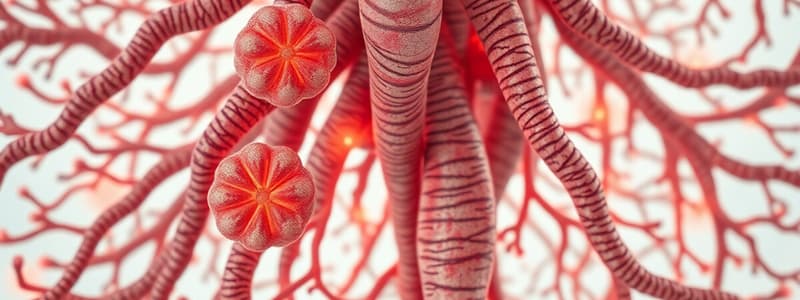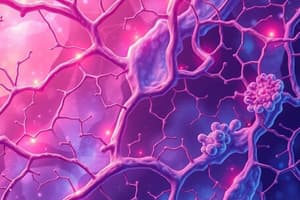Podcast
Questions and Answers
Which type of cartilage is characterized by small collagen fibers and is found at the ends of bones at synovial joints?
Which type of cartilage is characterized by small collagen fibers and is found at the ends of bones at synovial joints?
- Fibrocartilage
- Hyaline cartilage (correct)
- Elastic cartilage
- Dense regular cartilage
What is the main function of adipose tissue in specialized connective tissue?
What is the main function of adipose tissue in specialized connective tissue?
- Connects muscle to bone
- Stabilizing joints
- Stored energy and insulation (correct)
- Transports nutrients and waste
Which tissue is described as having no blood vessels and healing very slowly?
Which tissue is described as having no blood vessels and healing very slowly?
- Bone
- Tendons
- Blood
- Cartilage (correct)
What type of specialized connective tissue is responsible for intercellular transport and immune responses?
What type of specialized connective tissue is responsible for intercellular transport and immune responses?
Which type of connective tissue has a dense arrangement of collagen fibers and connects bone to bone?
Which type of connective tissue has a dense arrangement of collagen fibers and connects bone to bone?
What type of tissue lines the body's surfaces and cavities?
What type of tissue lines the body's surfaces and cavities?
Which of the following is NOT a primary type of tissue?
Which of the following is NOT a primary type of tissue?
What do endocrine glands secrete?
What do endocrine glands secrete?
Which type of connective tissue is characterized by a dense arrangement of collagen fibers?
Which type of connective tissue is characterized by a dense arrangement of collagen fibers?
Which type of epithelial tissue is structured with multiple layers for protection?
Which type of epithelial tissue is structured with multiple layers for protection?
What is the main component of fibrous connective tissue?
What is the main component of fibrous connective tissue?
Which of the following tissues is involved in generating electrical signals?
Which of the following tissues is involved in generating electrical signals?
Which fiber type in connective tissue is known for providing support?
Which fiber type in connective tissue is known for providing support?
What is one of the main functions of adipose tissue?
What is one of the main functions of adipose tissue?
Which system does the skin primarily belong to?
Which system does the skin primarily belong to?
How does the skin help in regulating body temperature?
How does the skin help in regulating body temperature?
Which characteristic of the epidermis provides its waterproof quality?
Which characteristic of the epidermis provides its waterproof quality?
What is one of the reasons light-skinned individuals may face more challenges in sunny regions?
What is one of the reasons light-skinned individuals may face more challenges in sunny regions?
What role does melanin play in the skin?
What role does melanin play in the skin?
What kind of cells produce melanin in the skin?
What kind of cells produce melanin in the skin?
Which system includes the skin as its protective barrier against infection?
Which system includes the skin as its protective barrier against infection?
Flashcards
Epithelial Tissue
Epithelial Tissue
Covers body surfaces and lines body cavities, made of sheets of cells.
Connective Tissue
Connective Tissue
Connects and supports different body parts, its matrix (non-living material) is significant.
Simple Epithelium
Simple Epithelium
Single layer of epithelial cells, facilitating exchange and secretion.
Stratified Epithelium
Stratified Epithelium
Signup and view all the flashcards
Exocrine Glands
Exocrine Glands
Signup and view all the flashcards
Fibrous Connective Tissue
Fibrous Connective Tissue
Signup and view all the flashcards
Loose Connective Tissue
Loose Connective Tissue
Signup and view all the flashcards
Dense Irregular Connective Tissue
Dense Irregular Connective Tissue
Signup and view all the flashcards
Connective Tissue Types
Connective Tissue Types
Signup and view all the flashcards
Cartilage Characteristics
Cartilage Characteristics
Signup and view all the flashcards
Types of Cartilage
Types of Cartilage
Signup and view all the flashcards
Bone Structure
Bone Structure
Signup and view all the flashcards
Blood Composition
Blood Composition
Signup and view all the flashcards
Adipose tissue function
Adipose tissue function
Signup and view all the flashcards
Integumentary System
Integumentary System
Signup and view all the flashcards
Epidermis function
Epidermis function
Signup and view all the flashcards
Skin protection against dehydration
Skin protection against dehydration
Signup and view all the flashcards
Skin temperature regulation
Skin temperature regulation
Signup and view all the flashcards
Skin protection mechanism
Skin protection mechanism
Signup and view all the flashcards
Melanocytes function
Melanocytes function
Signup and view all the flashcards
Skin senses
Skin senses
Signup and view all the flashcards
Study Notes
Introduction to Tissues and the Skin
-
The study focuses on four primary tissue types: epithelial, connective, muscle, and nervous.
-
Epithelial tissue lines body surfaces (like the epidermis, inner lining of blood vessels, digestive tract, etc.) and forms glands.
-
Connective tissue connects and supports various body parts (tendons, ligaments, cartilage, bone, adipose tissue, organs).
-
Muscle tissue enables movement (skeletal, cardiac, and smooth).
-
Nervous tissue generates electrical signals for information transmission.
Epithelial Tissues
- Epithelial tissues line body cavities and cover surfaces.
- They consist of sheets of connected cells.
- Simple epithelium (one layer) facilitates substance exchange and secretion.
- Stratified epithelium (multiple layers) provides protection from abrasion and infection.
- Examples include simple squamous epithelium lining blood vessels and air sacs of lungs and stratified squamous epithelium composing the outer layer of skin, mouth, and vagina.
Glands: Epithelial Tissue
- Glandular epithelia produce and secrete chemicals.
- Exocrine glands secrete substances into hollow organs (e.g., saliva into the mouth, digestive acids/enzymes into the stomach).
- Endocrine glands secrete hormones directly into the bloodstream.
Connective Tissue Supports and Connects Body Parts
- Connective tissue cells are not densely packed. The protein matrix (produced by cells) is crucial for connective tissue's structure.
- Connective tissue can be classified as 'fibrous' or 'specialized'.
Fibrous Connective Tissue
- The protein matrix features collagen fibers (strength and flexibility), elastin fibers (stretchiness and flexibility), and reticular fibers (supportive thinner collagen).
- Fibroblasts produce the protein matrix. Other cell types include white blood cells and fat storage cells.
- The ground substance is a gel-like material composed of polysaccharides, water, and proteins.
- Loose fibrous connective tissue is abundant, flexible, and surrounds organs, muscles, and blood vessels.
- Dense fibrous connective tissue is characterized by denser collagen fibers, is less flexible, and surrounds organs requiring resistance to stretching (e.g., kidneys).
- Elastic fibrous connective tissue contains more elastin fibers and surrounds organs needing flexibility (e.g., stomach, bladder).
- Dense regular connective tissues (e.g., tendons connect muscle to bone, ligaments connect bone to bone) have parallel collagen fibers.
Specialized Connective Tissue
-
Cartilage: Chondroblasts form and maintain cartilage's protein matrix. Cartilage heals slowly due to lack of blood vessels. Types include:
-
Hyaline cartilage: smooth, found at end of bones in joints, part of nose, ribs, etc.
-
Elastic cartilage: more flexible, found in ears and epiglottis.
-
Fibrocartilage: resilient and strong, found in vertebral discs and knee cushions.
-
Bone: Bone matrix is hardened by calcium and phosphate. Osteocytes (bone cells) are interconnected with blood vessels for nutrient and waste exchange. Bone heals relatively quickly.
-
Blood: Blood (plasma, red blood cells, white blood cells, platelets) originates in red bone marrow and facilitates intercellular transport, immune function, and clotting.
-
Adipose Tissue: Adipose tissue comprises fat cells and provides insulation and cushioning (e.g., in the hypodermis, around kidneys).
Organs and Organ Systems Perform Complex Functions
- Tissues form organs, and coordinated organs form organ systems.
- Examples of organ systems include integumentary, nervous, skeletal, sensory, muscular, endocrine, blood, circulatory, immune, respiratory, digestive, urinary, and reproductive systems.
Skin: The Integumentary System
-
The skin comprises three layers: epidermis (outermost), dermis (middle), and hypodermis (innermost).
-
The epidermis is a protective layer composed of flattened keratinocyte cells.
-
The dermis contains collagen fibers as well as hair follicles, oil glands, sweat glands, blood vessels, nerve endings (for sensations), and smooth muscles.
-
The hypodermis is primarily adipose tissue for insulation and cushioning.
-
Skin functions include preventing dehydration , protecting, regulating temperature, sensing stimuli, producing vitamin D, and protecting against UV radiation.
Advantages and Disadvantages of Different Skin Colors
- Dark skin provides protection against skin cancer in sunny regions but might have difficulties making vitamin D in low-sun regions.
- Light skin, though more susceptible to skin cancer, generally produces more vitamin D in low-sun areas.
The Epidermis (Epithelial Tissue)
- The epidermis has a waterproof outer layer formed by keratin protein.
- Living epidermal cells migrate to the surface and die, becoming part of the outer layer.
- Melanocytes produce melanin, protecting against UV damage and skin cancer.
Additional Notes:
- Dermis is largely collagen fibers.
- Hair is formed by keratinocyte cells.
- Oil and sweat glands contribute to skin's functions.
- Blood vessels regulate temperature.
- Sensory nerve endings provide various sensory information.
- White blood cells defend against infection.
Studying That Suits You
Use AI to generate personalized quizzes and flashcards to suit your learning preferences.




